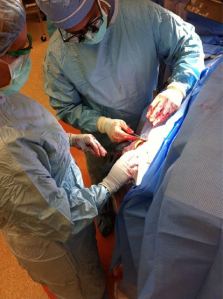 Yesterday, I attended a neurosurgery of the brain in an epileptic patient. I was right there next to the patient, the surgeons, Dr. Morris and Dr. Dagam, and all the other staff. I could see how the layers of tissue were slowly removed to expose the brain and I know what the patient, who was awake during the operation, said. I really was there. However, I had not washed my hands thoroughly before, I was not wearing a mask. Actually, I was sitting in Plaza Nueva in Bilbao with a coffee and my laptop, taking advantage of free wi-fi. And I was on Twitter…
Yesterday, I attended a neurosurgery of the brain in an epileptic patient. I was right there next to the patient, the surgeons, Dr. Morris and Dr. Dagam, and all the other staff. I could see how the layers of tissue were slowly removed to expose the brain and I know what the patient, who was awake during the operation, said. I really was there. However, I had not washed my hands thoroughly before, I was not wearing a mask. Actually, I was sitting in Plaza Nueva in Bilbao with a coffee and my laptop, taking advantage of free wi-fi. And I was on Twitter…
By chance, I came across this tweet:
 Although I found it a bit over the top, I must say it got me curious, and before long I was actually pretty drawn to the live-tweets.
Although I found it a bit over the top, I must say it got me curious, and before long I was actually pretty drawn to the live-tweets.
From the Regional Epilepsy Center at Aurora St. Luke’s Medical Center (Aurora Health Care) in Milwaukee, Wisconsin, a live-tweet of an awake temporal lobectomy (read more about temporal lobectomy here) on the epileptic,  43-year-old Geoffery Nestor took place on September 27, 2011. The objective of the surgery was to remove a portion of the brain which causes the epileptic attacks. It is the most common type of epilepsy surgery and is also the most successful type.
43-year-old Geoffery Nestor took place on September 27, 2011. The objective of the surgery was to remove a portion of the brain which causes the epileptic attacks. It is the most common type of epilepsy surgery and is also the most successful type.
Being quite certain that the surgeons had their hands full, the tweets were written by people from the hospital’s Social Media & Digital Communications, however present in the room and in close contact with both the patient and the doctors.
The tweets were in some cases accompanied by photos and varied between:
- technical descriptions (eg. “Dr. Dagam anchors the dura to the cranial wall using sutures, allowing full & safe access to brain http://yfrog.com/khxtbdoj”),
- descriptions of what was being done to the patient to keep him comfortable and stable,
- but also comments from the awake patient Geoff (eg.”Geoff says to Dr. Morris: “Tell my wife I love her. And that this isn’t as bad as I thought it would be.“).
- In addition, and some of the tweets gave general statistics on the number of epileptic patients in the US, information about the operation and instruments used etc. All in all a good variation.
Using the hashtag #ahcneuro it was of course possible for the followers to comment, retweet etc. It was interesting to see for example how epilepsy patient organisations were retweeting and encouraging their followers to follow the surgery. Questions and comments raised to the tweeters were in most cases responded to which gave a very good and interactive feeling.
Although this was my first experience with live-tweeted surgeries, it is not the first of its kind. I haven’t been able to find out which was the first Twitter-broadcasted surgery, but a minor robotic cancer surgery in Henry Ford Hospital in Detroit in January 2009 seems to have been one of the first. Since then knee surgeries have been tweeted, kidney operations and most likely other operations have made it to Twitter. The phenomenon has in some cases even been given a name : Twurgery. Live-twitter surgeries have even made it to the television screens in an episode of Grey’s Anatomy.
Judging from the website descriptions of the live-tweeting surgeries, the premise behind the events have been to give people an inside look at how an operation is performed, but in some cases also to display the advances that have been made in modern surgery. For example the Ohio State University Medical Center highlighted to following reasons to live tweet from a knee surgery:
- First, the health system wanted to publicize the availability of the procedure, which it calls (pdf) MAKOplasty, to patients and referring physicians.
- Second, the broadcasting and tweeting were another means of providing education to OSU medical students, particularly those interested in orthopedic
So far, I haven’t been able to identify live-twitter surgeries in hospitals outside the US, and I’m quite convinced that such an event have surely not taken place in a Danish operation room. Will it come? Well, I can’t really see why it shouldn’t. Of course things can always be miss used and there needs to be a clear objective and it does of course require consent from all parties involved. Learning from their experiences, some of the hospitals who have already tested live-tweeting have shared best practices and lessons-learned, which other hospitals might want to check out before sending tweeters into the operation rooms.
 To me, if done in a proper manner, this is an interesting way to do science communication. Getting not just medical staff but also the rest of us into the operation room once in a while, is not such a bad idea. People working with public health also need to know what actually happens in an operation room. And with Twitter we can be there without being in the way, faint over the amount of blood or ask questions at inconvenient times. In stead we can be sitting on Plaza Nueva in Bilbao, Spain drinking a coffee..
To me, if done in a proper manner, this is an interesting way to do science communication. Getting not just medical staff but also the rest of us into the operation room once in a while, is not such a bad idea. People working with public health also need to know what actually happens in an operation room. And with Twitter we can be there without being in the way, faint over the amount of blood or ask questions at inconvenient times. In stead we can be sitting on Plaza Nueva in Bilbao, Spain drinking a coffee..


